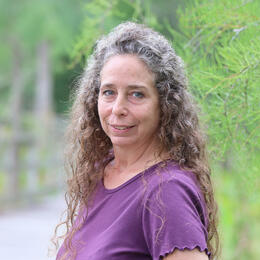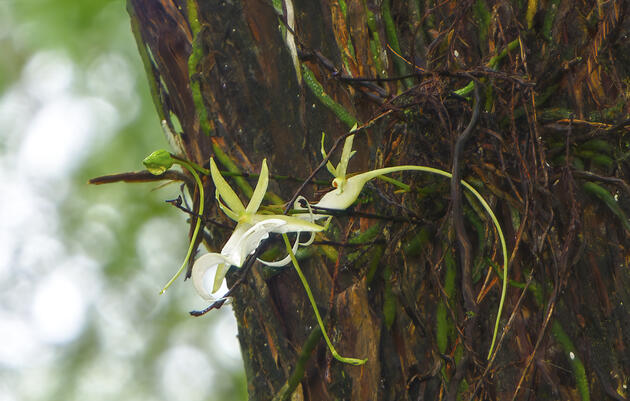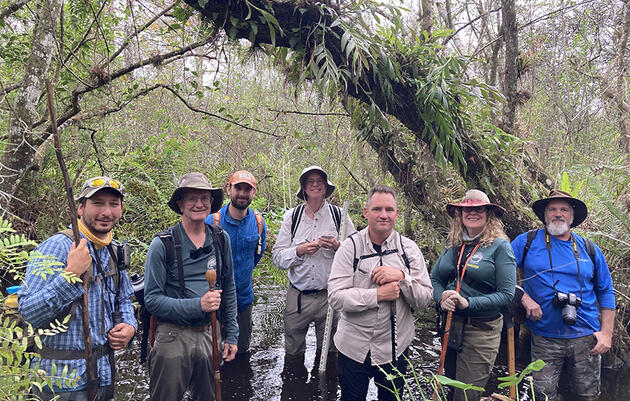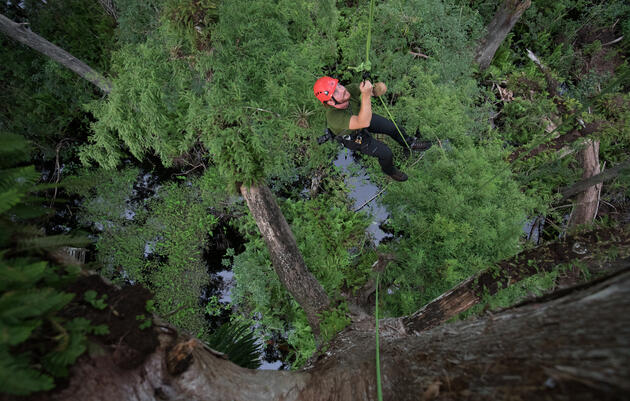Since it was discovered in July 2007, the "Super" ghost orchid (Dendrophylax lindenii) at Corkscrew Swamp Sanctuary has been in the international spotlight every summer. Ghost orchids are considered, by some, to be Collier County’s “crown jewel.” Found nowhere else in the U.S., their delicate white blossoms that dance in the breeze captivate all who view them, from orchid enthusiasts and botanists to photographers and even the casual observer.
On July 10, researchers and admirers gathered for a Ghost Orchid Symposium at the University of Florida’s IFAS office in Collier County. Eleven presentations covered the special conditions they need, the scent of their nectar, their international significance, current population estimates, and work underway to study and preserve these special plants for future generations.
The list of distinguished speakers included Lawrence Zettler, PhD, professor at Illinois College and research associate at Chicago Botanic Garden; Mark Danaher, supervisory wildlife biologist, U.S. Fish and Wildlife Service; Adam Herdman, PhD student, University of Florida; John Parke Wright IV, president, J.P. Wright & Company, Inc. and chairman of Orchid Conservation Chelsea; Reece Tolworthy, head of business development and sales, GrowTropicals from Leeds, U.K.; Tony Ruiz (chemical analysis of nectar); Toby McTamney, year 10 survey assistant; Nick Ewy, director of collections, Naples Botanical Garden; Johanna Hutchins, floriculturist, Chicago Botanic Garden; Michael Kane, PhD, Emeritus professor, University of Florida; and Keith Laakkonen, director, Corkscrew Swamp Sanctuary.
Dr. Zettler kicked off the symposium. He explained that, amongst the plant kingdom, orchids are the most vulnerable to acute environmental changes—like canaries in a coal mine, they can alert us to issues that affect all life in the swamp. Zettler explained that Florida harbors 106 species of orchids—roughly half of all orchid species in North America, with the most diversity in two Collier County locations: Florida Panther National Wildlife Refuge and Fakahatchee Strand State Preserve.
Per Zettler, most ghost orchids germinate on the north side of trees with rough bark, such as bald cypress, pop ash, and pond apple, which are plentiful in swamps like Corkscrew. These orchids have a specific recipe for survival: the climate and ecology of subtropical wetlands, fungus for germination, and insects to pollinate them.
Because they grow deep in swamps, many details about ghost orchids were unknown until recent decades. Another presentation outlined research undertaken in 2018 in the Florida Panther National Wildlife Refuge (and Corkscrew Swamp Sanctuary) that debunked a long-standing hypothesis that ghost orchids relied on a single pollinator, the giant sphinx moth. The research identified multiple species of moth that can do the job, which is great news for ghost orchids.
Adam Herdman summarized his research as part of a 10-year project studying ghost orchids. It entailed working with land managers including the National Audubon Society, botanists, and other experts to understand ghost orchid populations with special emphasis on age classes and reproductive success.
Herdman's work documented a decline in ghost orchid numbers, especially since 2017 when Hurricane Irma ripped through Collier County. The monster storm knocked down many trees, leaving acres of old-growth forests devoid of the leafy canopy that protects the crucial combination of humidity, temperature, and pH necessary for ghost orchids to thrive. After the storm, population estimates from the six known ghost orchid habitats were reduced from more than 2,000 individuals to 875 living plants, including approximately ten in the Sanctuary’s old-growth forest.
But the numbers aren’t all going down, thanks to propagation techniques that are being studied and improved at the Naples Botanical Garden. Garden scientists described their work to investigate population genetics, cryopreservation, and best practices for the reintroduction of ghost orchids grown from seeds in a laboratory. A new facility currently under construction at the garden aims to perfect these techniques.
The symposium concluded with a short presentation by Sanctuary Director Keith Laakkonen. He spoke about the “Super” ghost orchid, describing how visitors discovered it when looking for an owl, what makes it so super (it is large and puts out many blossoms over the course of a year), and that Corkscrew Swamp Sanctuary provides the only opportunity for people to see this unusual plant in its natural habitat without wading through a swamp.
Because these plants require such a special combination of environmental factors to survive, several entities are encouraging efforts to list the ghost orchid as a federally endangered species. They anticipate this would be good news for all Floridians because if ghost orchids and their habitat are protected, Florida’s water supply is also protected.







